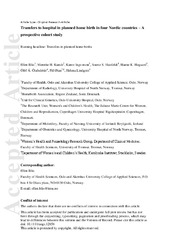Transfers to hospital in planned home birth in four Nordic countries – A prospective cohort study
Permanent link
https://hdl.handle.net/10037/8945DOI
doi: 10.1111/aogs.12858Date
2016-02-29Type
Journal articleTidsskriftartikkel
Peer reviewed
Author
Blix, Ellen; Kumle, Merethe; Ingversen, Karen; Huitfeldt, Anette; Hegaard, Hanne Kristine; Olafsdottir, Olof Asta; Lindgren, HelenaAbstract
Material and methods. Women in Norway, Sweden, Denmark and Iceland who had opted for, and were accepted for, home birth at the onset of labor, were included in the study. Data from 3068 women, 572 nulliparas and 2446 multiparas, were analyzed for proportion of transfers during labor and within 72 hours after birth, indications for transfer, how long before or after birth the transfer starte d, time from birth to start of transfer, duration and mode of transfer, and whether the transfer was classified as potentially urgent. Analyses were stratified for nulli - and multiparity.
Results. One third (186/572) of the nulliparas were transferred to hospital, 137 (24.0%) during labor and 49 (8.6%) after the birth. Of the multiparas, 195/2446 (8.0%) were transferred, 118 (4.8%) during labor and 77 (3.2%) after birth. The most common indication for transfers during labor was slow progress. In transfers after birth, postpartum hemorrhage, tears and neonatal respiratory problems were the most common indications. A total of 116 of the 3068 women had transfers classified as potentially urgent.
Conclusions. One third of all nulliparous and 8.0% of multiparous women were transferred during labor or within 72 hours of the birth. The proportion of potentially urgent transfers was 3.8%.


 English
English norsk
norsk